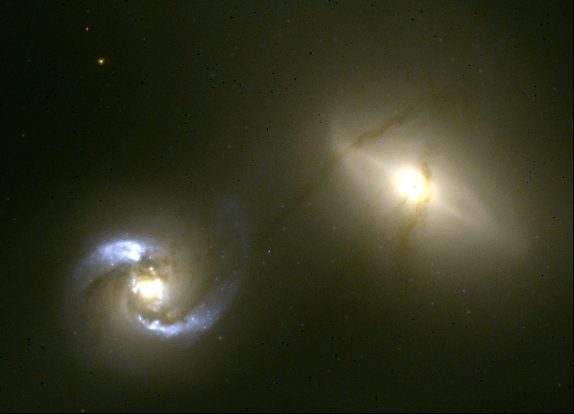
This is additional information to accompany the HST photo release. Much is from Keel's presentation at the January 2001 meeting of the American Astronomical Society in San Diego.
I present two-band HST STIS imaging of ongoing mass transfer in the interacting galaxy pair NGC 1409/10 (where NGC 1410 is the Seyfert galaxy often listed as III Zw 55). Archival snapshot WFPC2 imaging from the survey by Malkan et al. showed a dust feature stretching between the galaxies, apparently being captured by NGC 1409. The new images allow estimates of the mass being transferred and rate of transfer. An absorption lane typically 0.25" (100 pc) wide with a representative optical depth tB =0.2 cuts across the spiral structure of NGC 1410, crosses the 7-kpc projected space between the nuclei, wraps in front of and, at the limits of detection, behind NGC 1409, and becomes a denser (tB =0.4) polar ring around the core of NGC 1409. Models for the light distribution in the two galaxies allow a crude three-dimensional recovery of the dust structure, supporting the front/back geometry derived from colors and extinction estimates. The whole feature contains of order 5000 solar masses in dust, implying about 8 × 105 solar masses of gas. Incorporating the projected velocity difference between nuclei for a timescale, this suggests a very modest mass transfer rate averaging about 0.02 solar masses per year unless we are particularly unlucky in viewing angle. Curiously, this demonstrable case of mass transfer seems to be independent of the occurrence of a Seyfert nucleus, since the Seyfert galaxy in this pair is the donor of the material.
This work was support by NASA through STScI grant GO-8147.01-97A. The WIYN Observatory is owned and operated by the WIYN Consortium, Inc., which consists of the University of Wisconsin, Indiana University, Yale University, and the National Optical Astronomy Observatory (NOAO). NOAO is operated for the National Science Foundation by the Association of Universities for Research in Astronomy (AURA), Inc.
The dust lane tracing the mass transfer has been investigated using two images in broad-band filters obtained with the STIS instrument on the Hubble Space Telescope. These images were used to make the following color-composite images reflecting the galaxies' appearance from the near-ultraviolet to near-infrared, approximately reproducing the visual colors.

The left-hand (northern) galaxy is NGC 1410, catalogued as a Seyfert galaxy (also known as III Zw 55). NGC 1409 is a lenticular galaxy lacking clear spiral arms or star formation, seen here by its reddish and uniform color. The dust lane leaves NGC 1410, crosses the gap, and disappears where it would go behind the starlight of NGC 1409 if it connects to the polar dust seen in front of the nucleus; in fact the STIS data give some support from color data that it is going behind rather than ending. The structure is better seen in this enhancement of the white-light 50CCD STIS image (left), which has been divided by a smooth model to show the dust absorption more clearly, and in a color-ratio image (right), where redder regions map as red, and the slight "greying" of the dust extinction as it passes NGC 1409 suggests that it is going behind the starlight.
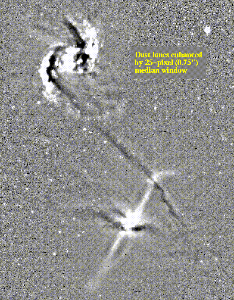
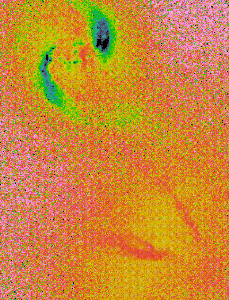
The situation can be further explored, using a velocity map of the ionized gas in these galaxies obtained in December 2000 with the Dense-Pak fiber array at the 3.5-m WIYN telescope on Kitt Peak. As shown in the following panels, NGC 1410 is approaching relative to NGC 1409, and is rotating in about the same direction as the orbits. It thus undergoes a direct (prograde) encounter, most favorable to producing tidal tails. NGC 1410 is at right angles to the orbital plane (again, more or less) so that incoming material parking in near-polar orbits makes sense.
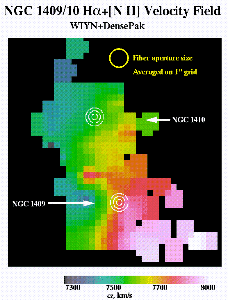
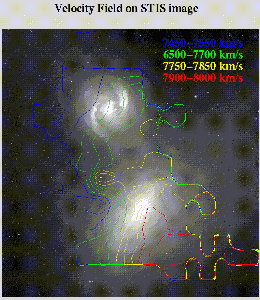
Putting these pieces together gives the following sketch of the spin and orbit directions in this system, show with the observed and inferred dust locations. This shows graphically how the data indicate different encounter senses for the two galaxies, and how a wrapping of the dust lane around NGC 1409 satisfies the velocity structure from the gas as well as the morphology of the absorption.
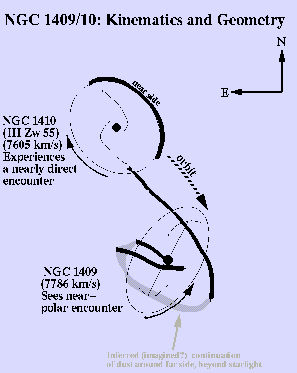
These WIYN spectra show the two nuclei, after subtracting a scaled starlight estimate from NGC 1409. It shows similar linewidths to the known Seyfert NGC 1410 in Ha and [N II], plus evidence of a broad component at Ha. Maybe at least the nucleus does know that material is being dumped into the galaxy. The Ha fluxes differ by a factor 15, implying an ionizing luminosity of a few times 1040 ergs/second. This could easily be powered by the mass transfer, and would be a small fraction of the Eddington luminosity for central masses more than a few thousand solar masses. Though the activity is weak enough not to require mass transfer, this at least is not a problem for getting rid of infalling gas.
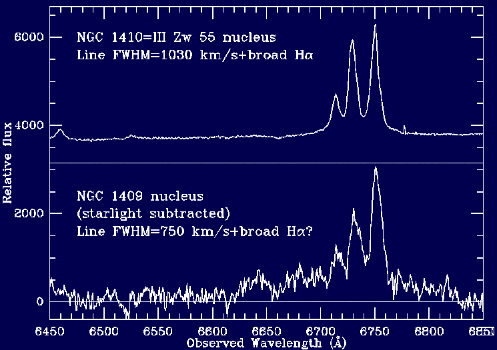
NGC 1409/10 is a very clear example of mass transfer, where the dust lets us follow material from the donor disk most of the way to a polar ring around NGC 1409. The mass we see isn't much (less than 5000 solar masses in dust, perhaps 106 including gas for a typical ratio), so unless our viewing direction is more odd than the velocity field suggests, a mere 0.02 solar masses per year is making the trip. And all of that is following a single narrow luge track. The amount of mass and narrowness of the dust lanes suggest that this is a single molecular-cloud and dust complex which was in just the right place to be sheared tidally. Backward tracing in numerical simulations shows that tidal features often start from a very small part of the disturbed disk.
The evidence is strong that star formation is enhanced by interactions, and mixed-morphology pairs suggest that mass transfer is sometimes involved. However, many starbursts in interacting pairs are forming stars at estimated rates in the tens of solar masses per year, four orders of magnitude faster than we see the dumping in this example. Such high rates would already have been obvious in ground-based imaging from the accompanying dust, and therefore are not common. Some resulting possible implications for mass transfer and starbursts are:
To my delight, links to this page have generated some questions from the Internet audience. This may not be surprising, since the original material was laid out for a technical meeting. As in some classes, the things I imagine will generate questions are not the same as the ones that people really want to know... So here's a selection with my responses.
Couldn't the matter be funneling into a black hole in the heart of NCG 1409, thereby being unusable for stellar formation?
This was one of the things I looked for, and may be happening at a low level (the import of the stuff above about active nuclei). This can't be happening to the material we clearly see, because even a supermassive black hole and attendant accretion disk would give a target less than a light-year in radius. To "feed the monster", the gas has to get close enough for cloud collisions and the effects of gas viscosity to help sap its orbital energy and angular momentum. This leaves a factor of a thousand between where we see the infalling material and where it would have to go. New spectra do suggest a "simmering" black hole in NGC 1409, but at such a low level that it could be fuelled by gas released from stars (in planetary nebulae and supernova explosions) within NGC 1409 itself. It is a strong possibility that, given enough time, this material could pile up at the core of NGC 1409. The star-formation problem is simply that so much gas and dust would normally be expected to form stars right where we see it, so there may be some interesting questions of dynamics as to why we don't see that happening.
How do we know this isn't just a fortuitous alignment of the galaxies, wherein the background galaxy provides the illumination to reveal an independent feature of the foreground galaxy? (As Commander Uhura said in Star Trek VI, "That thing must have a tailpipe...")
Aha! This business of finding unrelated galaxies to illuminate dust features has been a favorite of mine. In this case, the two galaxies share a common envelope of stars, outside the image we showed to illustrate the dust. One reason the new STIS images were needed was to see whether the colors in the dusty areas showed the characteristic change to be expected if the material actually wraps around NGC 1409 instead of just lying in front and ending in a suspiciouc place. So far, the signature (a change in the relation between amount of starlight missing and how much it's reddened as more of the starlight comes from in front of the dust) shows what we'd expect as the dust goes about halfway around, at which point there's so little starlight behind it that it becomes hard to detect. As several people have pointed out, 21-cm radio observations might be able to detect it on the far side, but the feature is so small that it will be a challenge to do even with the VLA.
From the length of the "matter ribbon" these galaxies appear to have an extended history of interaction yet their overall galaxy structures do not show any extensive distortions. Why not?
Wish I had more people in my intro class who were thinking this fast. The main evidence is something that we couldn't get to show up in the same image display as the whole dust lane - the galaxies are surounded by a common envelope of stars, including two tidal tails, pulled out from the main bodies during their gravitational dance. The released image shows only the inner parts of the whole system. Here's a wider view, in false color and a logarithmic brightness scale, to show the fainter outer regions. In brief, the answer is that they do indeed have a long history, including at least one close approach some time before we now see them. In fact, the spiral pattern in NGC 1410 may have been induced by this gravitational perturbation rather than being original equipment; it's easy for external gravitational effects to excite such "grand-design" patterns, which is why many of the pretty spirals in textbook pictures have big companions (such as M51 and M81). You may want to have a look at my interacting-galaxy gallery for more examples of how gravity can really bend galaxies out of shape.
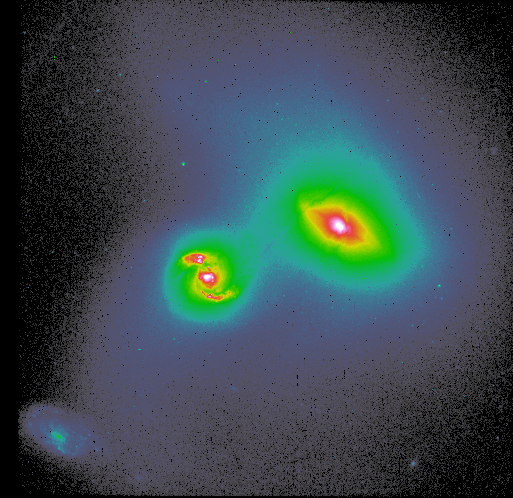
Some relevant links:
Last changes: 1/2001 © 2000,2001